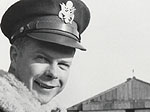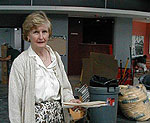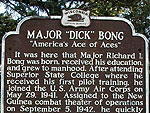By Bob Kelleher
Minnesota Public Radio
September 24, 2002
For forty years, a weathered warplane stood guard over the northern Wisconsin Village of Poplar. It probably didn't look like much to most people. But now, after a meticulous restoration, it's the centerpiece of a new museum in Superior.
| |
|
|
|
||
The twin-engined airplane over Poplar was called Marge. That was the name of Richard Bong's girlfriend, and then his wife. It was the name of the airplane Bong flew over the Pacific in World War Two; the plane that shot down 40 enemy aircraft: the most ever by an American Pilot. Richard Bong was Poplar's home town hero and America's Ace of Aces.
The P-38 over Poplar was Bong's memorial. It was a 1948 gift from America to a hero's home town. But decades later it was a sad memorial. Pat Clancey is a Master Sergeant with the Minnesota Air Guard in Duluth.
Clancey says the old plane had sat in the open for several years. "The weather had taken its toll on the aircraft itself just from sitting outside."
The Lockheed Lightning P-38 may be the under-rated hero of World War Two aviation.
It's an odd looking craft, with a cockpit bubble on the front and parallel fuselages front to back, each joining a wide tail. German Pilots called the P-38 "der Gabelschwanz Teufel" - "The Fork Tailed Devil." It was a term of honor for an ugly duckling that could down the best in the German Luftwaffe.
| |
|
|
|
||
Duluth Guardsmen were challenged to restore the historic warbird. But it wouldn't be easy. Marge's aluminum skin was dull, pitted and cracked. Vandals had taken everything that could be pulled or pried off -- often leaving nothing but beer cans in payment.
"The biggest thing" says Clancey, "would be to find missing instruments, and missing cockpit pieces that haven't been produced in fifty years."
Nearly ten thousand P-38's were manufactured; but only two dozen remain intact. Still, piece by piece, some twenty soldiers joined a handful of civilian volunteers in what became a labor of love. For three years they remanufactured, refitted and repainted the airplane. They brought it up to museum quality. And now it has its own museum.
"We got caught up into the excitement of seeing the museum come together, with the P-38 being the showpiece," Clancey says.
| |
|
|
|
||
The Richard I. Bong Heritage Center is a new landmark on Superior's waterfront. It's a gleaming silver and glass building on the main highway through town.
Museum Executive Director Christabel Grant steps across the tools and building materials piled about just days before the museum's opening.
"You are meant to be impressed at once," she says, "by the fact that it really does look like an aircraft hangar."
The P-38's display is made to look like a Pacific ocean island, complete with palm trees and sand beach. The rest of the Heritage Center tells the story of World War II, as viewed by the war's veterans, and those on the homefront. Twin Ports wartime shipbuilding and iron shipping is prominently displayed.
Grant says veterans and their families have provided artifacts and stories from around the nation.
| |
|
|
|
||
"Somebody," she says, "sent us a piece of a Japanese plane that a kamakazi pilot flew into his ship." Grant continues, "I think people respond to a personal story, and especially when they feel that it is their story."
The museum expects to tap the Twin Port's healthy tourism market. But the airplane's move from Poplar to Superior wasn't without controversy. It was an agonizing decision for the committee in charge - a committee largely made up of Poplar residents. They realized they'd never raise the money needed for a major project in the smaller town.
"I mean it was a difficult decision to move it," Grant says, "but you know, we've had such a warm welcome here."
| |
|
|
|
||
Grant is optimistic. Richard Bong has his own legion of followers.
According to Grant, "If we had built this at the North Pole, the Dick Bong fans would make their way up to the North Pole."
Bong's life ended when the war did. He died in the crash of an experimental jet, the same day the United States dropped an atomic bomb on Hiroshima. But Bong's legacy will live on, in the memories of the people of Poplar; and Bong's wife Marge, who still lives in the area; and in the airplane that carries her name.
More Information





